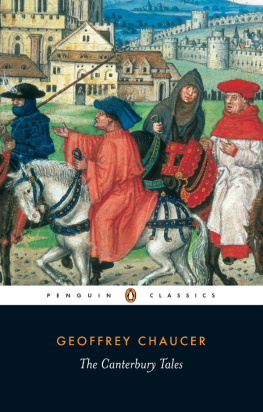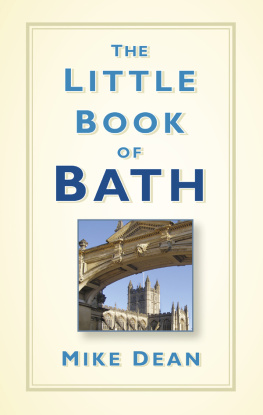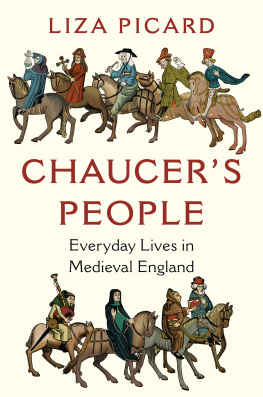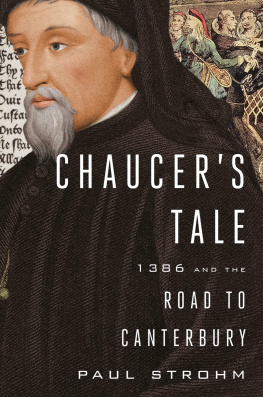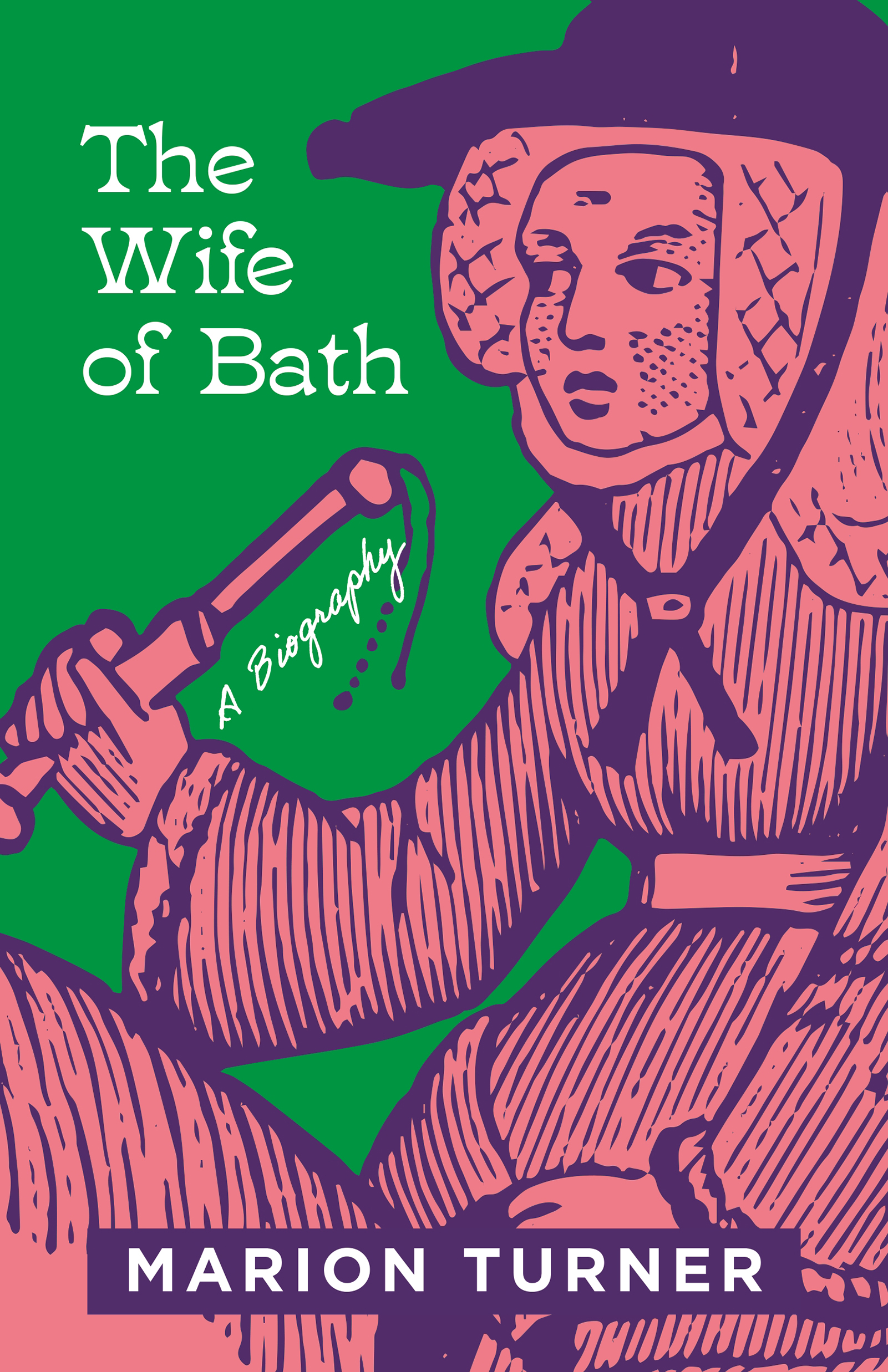The Wife of Bath
The Wife of Bath
A BIOGRAPHY
MARION TURNER

PRINCETON UNIVERSITY PRESS
PRINCETON AND OXFORD
Copyright 2023 by Marion Turner
Princeton University Press is committed to the protection of copyright and the intellectual property our authors entrust to us. Copyright promotes the progress and integrity of knowledge. Thank you for supporting free speech and the global exchange of ideas by purchasing an authorized edition of this book. If you wish to reproduce or distribute any part of it in any form, please obtain permission.
Requests for permission to reproduce material from this work
should be sent to
Published by Princeton University Press
41 William Street, Princeton, New Jersey 08540
99 Banbury Road, Oxford OX2 6JX
press.princeton.edu
All Rights Reserved
Library of Congress Cataloging-in-Publication Data
Names: Turner, Marion, 1976 author.
Title: The Wife of Bath : a biography / Marion Turner.
Description: Princeton : Princeton University Press, [2022] | Includes bibliographical references and index.
Identifiers: LCCN 2022026577 (print) | LCCN 2022026578 (ebook) | ISBN 9780691206011 (hardback ; acid-free paper) | ISBN 9780691206028 (ebook)
Subjects: LCSH: Chaucer, Geoffrey, 1400CharactersWife of Bath. | Wife of Bath (Fictitious character) | Chaucer, Geoffrey, 1400. Wife of Baths tale. | Women in literature. | BISAC: LITERARY CRITICISM / Medieval | BIOGRAPHY & AUTOBIOGRAPHY / Literary Figures | LCGFT: Literary criticism.
Classification: LCC PR1868.W593 T87 2022 (print) | LCC PR1868.W593 (ebook) | DDC 821/.1dc23/eng/20220608
LC record available at https: / /lccn.loc.gov/2022026577
LC ebook record available at https: / /lccn.loc.gov/2022026578
Version 1.0
British Library Cataloging-in-Publication Data is available
Editorial: Ben Tate and Josh Drake
Production Editorial: Jill Harris
Text Design: Heather Hansen
Jacket Design: Heather Hansen
Production: Danielle Amatucci
Publicity: Alyssa Sanford and Carmen Jimenez
Copyeditor: Molan Goldstein
Jacket image: Lebrecht Music & Arts / Alamy Stock Photo
for Peter and Cecilia,
who know the importance of painting the lion
Contents
- ix
Illustrations
Illustrations follow .
. The Wife of Bath in the Ellesmere Chaucer manuscript, c. 1400. EL 26 C 9, Egerton family papers. Copyright The Huntington Library, San Marino, CA, 72 r.
. The Pilgrimage Window, York Minster, early 14th century. Copyright Taken by The York Glaziers Trust, reproduced by kind permission of the Chapter of York.
. Vulva pilgrim brooch, Netherlands, late 14th or early 15th century. Copyright Van Beuningen Family Collection, HP1, cat. no. 663, Inv. 2184.
. The Ellesmere scribe comments on the Wife of Baths Prologue, c. 1400. EL 26 C 9, Egerton family papers. Copyright The Huntington Library, San Marino, CA, 63v.
. The Egerton scribe comments on the Wife of Baths Prologue, late 15th century. British Library Add MS 5140, 95r. Copyright British Library / GRANGER.
. The Egerton scribe comments on the Wife of Baths Prologue, late 15th century. British Library Add MS 5140, 88r. Copyright British Library / GRANGER.
. Frontispiece of The Wanton Wife of Bath, c. 1660. Copyright The Bodleian Library, Wood E 25 Ballads; part 93.
. Henry Fuseli, The bedroom scene from the Wife of Baths Tale, c. 1812. Petworth House and Park, West Sussex. Copyright National Trust Images / Derrick E. Witty.
. Henry Fuseli, Falstaff in the Laundry Basket, c. 1792. Copyright Kunsthaus Zrich, 1941.
. Lady Diana Beauclerk, illustration of the victim, from John Dryden, The Wife of Bath Her Tale, 1797. Copyright The Bodleian Library, Vet A5 b. 72, p. 197.
. Lady Diana Beauclerk, illustration of the bed scene, from John Dryden, The Wife of Bath Her Tale, 1797. Copyright The Bodleian Library, Vet A5 b. 72, p. 216.
. Laura Betti playing the Wife of Bath in Pier Paolo Pasolini, I Racconti di Canterbury. Copyright Produzioni Europee Associate (PEA)/Les Productions Artistes Associs, 1972
. Jan Sawka, poster advertising The Canterbury Tales/Opowieci Kanterberyjskie, Poland, 1976. Copyright ARS, NY and DACS, London, 2021/Victoria and Albert Museum, London.
. Marc Brenner, photograph of Clare Perkins playing the title role in Zadie Smith, The Wife of Willesden, Kiln Theatre, 2021.
The Wife of Bath
Introduction
It might have been my mother or it might have been the Wife of Bath.
HILARY MANTEL, THE MIRROR AND THE LIGHT, 595
Hilary Mantels reference to the Wife of Bath, in her wildly popular 2020 novel set in the time of Henry VIII, makes two assumptions: first, that modern readers know who the Wife of Bath is; and second, that they understand what she might have signified in Thomas Cromwells world. In this scene, Cromwell (Henry VIIIs right-hand man) is telling his closest colleagues about how Geoffrey de la Pole will respond to interrogation, saying that he will endlessly obfuscate and will keep contradicting himself, saying something happened in October or March; in Sussex (far south) or Yorkshire (in the north); that the person involved might have been his mother or might have been the Wife of Bath. The implication is that Chaucers heroine is as well known as the months or English geography or ones parents. And, although she is presented here as a foil to Geoffreys mother, in fact the two women are rather similar. Margaret de la Pole, suspected of treason to the king (and later executed for it), was a woman who, like Alison of Bath, challenged authority and went her own way, as many medieval women did.
Mantel correctly implies here that in the sixteenth-century and in the twenty-first, Alison of Bath was and is part of the cultural fabric of many English-speaking womens and mens lives. Why has this character from a fourteenth-century poem had such a dramatic impact across time?
The Wife of Bath is the first ordinary woman in English literature. By that I mean the first mercantile, working, sexually active womannot a virginal princess or queen, not a nun, witch, or sorceress, not a damsel in distress nor a functional servant character, not an allegory. A much-married woman and widow, who works in the cloth trade and tells us about her friends, her tricks, her experience of domestic abuse, her long career combatting misogyny, her reflections on the ageing process, and her enjoyment of sex, Alison exudes vitality, wit, and rebellious self-confidence. Alison is a character whom readers across the centuries have usually seen as accessible, familiar, and, in a strange way, real. For many people she is by far the most memorable of the Canterbury pilgrims. Almost from the moment of her conception, she exceeded her own text, appearing in Chaucers other writings (in a way no other character does) before being seized and appropriated by readers, scribes, and other poets alike. Over and over again, in different time periods and cultural contexts, readers see her as relatable in certain ways, as a three-dimensional figure who is far more than the sum of her parts. She may be ordinary, but she is also



